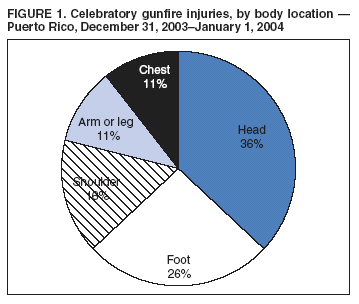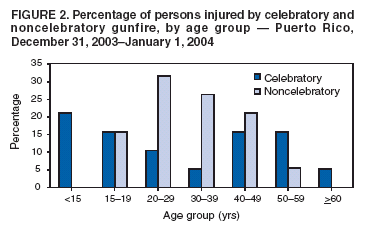 |
|
|
|
|
|
|
| ||||||||||
|
|
|
|
|
|
|
||||
| ||||||||||
|
|
|
|
|
Persons using assistive technology might not be able to fully access information in this file. For assistance, please send e-mail to: mmwrq@cdc.gov. Type 508 Accommodation and the title of the report in the subject line of e-mail. New Year's Eve Injuries Caused by Celebratory Gunfire --- Puerto Rico, 2003Bullets fired into the air during celebrations fall with sufficient force to cause injury and death (1). However, few data exist regarding the epidemiology of injuries related to celebratory gunfire. In Puerto Rico, where such celebratory actions are common, news media reports have indicated that approximately two persons die and an estimated 25 more are injured each year from celebratory gunfire on New Year's Eve. The Puerto Rico Department of Health (PRDOH) invited CDC and local law enforcement agencies to assist in the investigation of injuries resulting from celebratory gunfire that occurred during December 31, 2003--January 1, 2004. This report summarizes the findings of that investigation, which determined that 1) bullets from probable celebratory gunfire caused 19 injuries, including one death and 2) such injuries affected a higher percentage of women and children aged <15 years than injuries from noncelebratory gunfire, with the majority occurring in certain public housing areas in densely populated, metropolitan San Juan. Education and enforcement of existing laws are needed to prevent these injuries. A probable celebratory gunfire injury was defined as an unintentional firearm injury (International Classification of Diseases, Tenth Revision codes W32--W34 [2]) inflicted outdoors by an unidentified assailant during the 48-hour period beginning 12 a.m., December 31, 2003, and ending 11:59 p.m., January 1, 2004. Available information regarding the injury or event had to be consistent with the return trajectory of a bullet fired into the air. Cases were identified from newspaper and law enforcement reports and hospital and medical examiner records. For persons who sustained injuries from celebratory gunfire, information was collected on age, sex, time of injury, injury severity, body location of injury, and geographic location where the injury occurred. Age and sex information were also collected for persons who sustained injuries from noncelebratory gunfire that occurred during the study period. During the 2-day period, 43 persons were injured by gunfire. Of these injuries, 28 (65%) were identified as unintentional; 19 (68%) of those met the case definition for probable celebratory gunfire injuries. Median age of the 19 persons injured from celebratory gunfire was 24 years (range: 4 months--82 years); 12 (63%) were male. Four (21%) persons were hospitalized, including one who died from a head injury. The most common body location for injury from celebratory gunfire was the head (36%), followed by foot (26%) and shoulder (16%) (Figure 1). Of the 19 injuries, 18 (95%) occurred in metropolitan San Juan; 14 (78%) occurred among persons in 10 of the city's 51 public housing areas. Four public housing areas accounted for eight (42%) cases. Eight (42%) injuries occurred during 6 p.m.--10 p.m. on December 31, 2003, and nine (47%) injuries occurred between 10 p.m. on December 31, 2003, and 2 a.m. on January 1, 2004. The sex and age of the 19 persons with a probable celebratory gunfire injury were compared with the sex and age of 24 other persons with a noncelebratory gunfire injury. Seven (37%) persons who sustained injuries from celebratory gunfire were female, compared with three (13%) females among 24 persons with injuries from noncelebratory gunfire. Four (21%) persons who sustained injuries from celebratory gunfire were children aged <15 years; no injuries from noncelebratory gunfire occurred among this age group (Figure 2). Reported by: I Rodriguez, MS, B Mirabal-Colon, MD, Center for Hispanic Youth Violence Prevention, School of Medicine, Univ of Puerto Rico, San Juan; J Alonso-Echanove, MD, C Rodriguez, MS, J Rullan, MD, Puerto Rico Dept of Health. A Crosby, MD, I Arias, PhD, Div of Violence Prevention, National Center for Injury Prevention and Control; F Alvarado-Ramy, MD, Epidemiology Program Office; V Balaban, PhD, B Cauthen, MD, EIS officers, CDC. Editorial Note:When fired into the air, bullets can return to the ground at speeds greater than 200 ft./sec., a sufficient force to penetrate the human skull and cause serious injury or death (1). News media reports from around the world suggest that celebratory gunfire injuries might be a widespread public health problem; however, further data are needed to determine the extent of the problem. The data presented in this report indicate that bullets from probable celebratory gunfire caused 19 injuries, including one death, during December 31, 2003--January 1, 2004, in Puerto Rico. These injuries primarily occurred at midnight on December 31 in a limited number of public housing areas. Celebratory gunfire injuries affected a high percentage of children and females, populations not typically at high risk for such injuries. These findings are consistent with a previous study of celebratory gunfire injuries in a metropolitan area (1). Firearm-related injuries are a significant public health concern in Puerto Rico. In 2001, a total of 738 deaths were attributed to firearm injuries, a rate of 19.2 per 100,000 population, which is substantially higher than the U.S. national rate (10.4) and higher than the rates for all U.S. states (3). The celebratory gunfire injuries described in this report represent a small but preventable proportion of firearm injuries in Puerto Rico. The findings in this report are subject to at least three limitations. First, no standards exist for defining cases of celebratory gunfire injuries. For example, the "lost bullet" classification used by Puerto Rico law enforcement does not differentiate between falling bullets and stray bullets. The data sources used in this study were not developed for identifying celebratory gunfire injuries and provided limited context information, preventing definitive confirmation of falling bullet trajectory for some injuries. In addition, law enforcement records did not record injury severity, and not all medical records contained adequate information to determine injury severity; therefore, injury severity was not analyzed. Second, the lack of electronic databases containing records for previous years limited evaluation of possible trends. Finally, no information was available regarding persons who used firearms, and no direct information was available from victims and witnesses, who might have provided information about the circumstances of the injuries. To limit celebratory gunfire, in 2002, the Puerto Rico legislature increased penalties for reckless discharge of firearms. In addition, previous prevention efforts by PRDOH included a public awareness campaign advising residents to remain indoors from 11 p.m. on New Year's Eve to 2 a.m. on New Year's Day (J. Alonso, MD, PRDOH, personal communication, 2004). PRDOH, in collaboration with local law enforcement and the Puerto Rico Departments of Family, Housing, and Education, is participating in a multi-agency prevention effort for New Year's Eve 2004 to reduce celebratory gunfire injuries. On the basis of this study, investigators made several recommendations to the Puerto Rico Ministry of Health. First, existing laws against celebratory gunfire should be actively enforced. Second, PRDOH, in collaboration with community leaders of public housing areas, should develop a campaign focused on changing attitudes and behaviors toward celebratory gunfire in these areas. Third, to minimize the risk for injury from celebratory gunfire, residents should remain indoors from 6 p.m. on New Year's Eve to 2 a.m. on New Year's Day. Finally, to more accurately monitor these and other injuries over time, an emergency department--based injury surveillance system should be implemented. Acknowledgments The findings in this report are based, in part, on contributions by A Correo, V Colon, P Fuentes, Puerto Rico Police Dept; J Acosta, MD, N Almodóvar, M Ayala Molina, Medical Svcs Admin; M Conte, MD, Puerto Rico Forensic Institute; M Franco Ortiz, PhD, J Rivera, MD, Center for Hispanic Youth Violence Prevention, School of Medicine, Univ of Puerto Rico, San Juan.. References
Figure 1  Return to top. Figure 2  Return to top.
Disclaimer All MMWR HTML versions of articles are electronic conversions from ASCII text into HTML. This conversion may have resulted in character translation or format errors in the HTML version. Users should not rely on this HTML document, but are referred to the electronic PDF version and/or the original MMWR paper copy for the official text, figures, and tables. An original paper copy of this issue can be obtained from the Superintendent of Documents, U.S. Government Printing Office (GPO), Washington, DC 20402-9371; telephone: (202) 512-1800. Contact GPO for current prices. **Questions or messages regarding errors in formatting should be addressed to mmwrq@cdc.gov.Page converted: 12/22/2004 |
|||||||||
This page last reviewed 12/22/2004
|